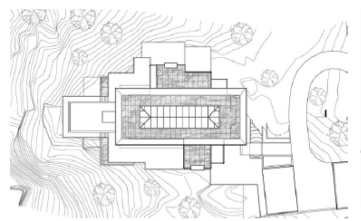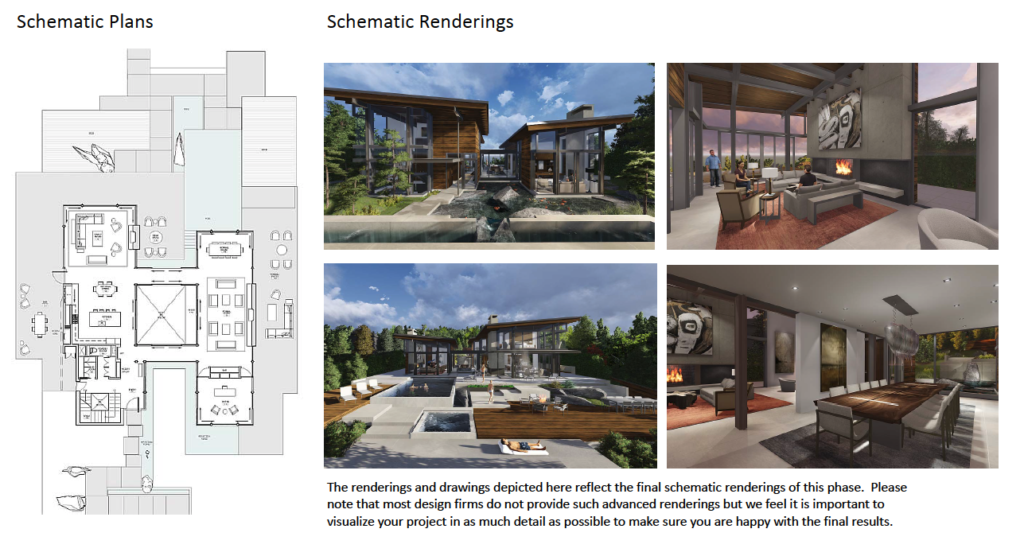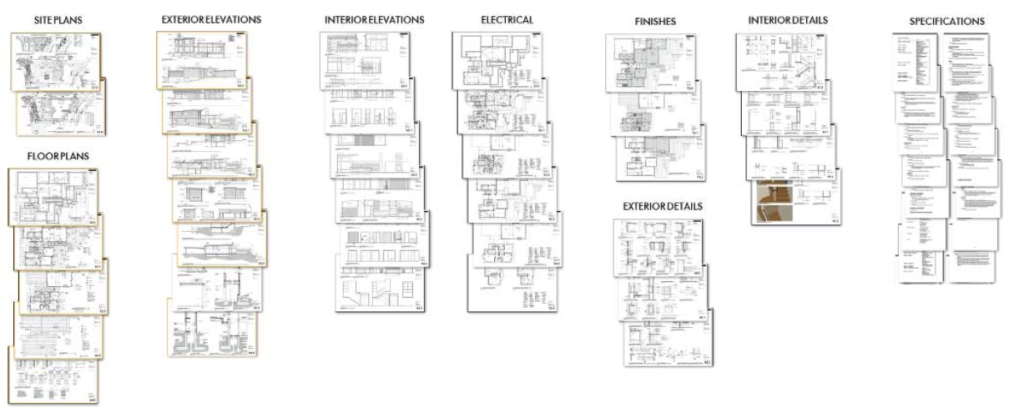The Design & Build Process

Whether you are designing a new home, renovating an existing space, or simply wanting to complete interiors, the process should be easy to understand and be a
rewarding collaboration from start to finish. To help you better understand the process of your new home project we have created this summary to better help you understand how we work.
Phase 1 – PROGRAMMING
In this phase of the design process we decide what to build. To begin, you provide us with a wish list of all aspects of the home desired. This will include basic information like the number of bedrooms, bathrooms, size of the home, level of finish, budget, etc., as well as any other detailed information. Often clients bring in a scrap book of images, or provide us with an on‐line idea book from a source such as Houzz.com We strongly suggest that at this phase a reputable builder is selected that has experience with the type of architecture and details that are desired. It is critical that the builder chosen has a good reputation working & partnering with architects. Without this experience many builders are unprepared for the level of detail required and may not account for this cost in the budget. The builder is a key player in the success of the project and to provide feedback at each phase of the design process.At this stage we also check to see if your goals and aspirations are realistic given the budget provided. We then weigh these against industry standard building costs, builder input, and current market driven costs per square foot. With this information in‐hand we modify the goals accordingly and then create a realistic written program for the home from which the home will be designed. Also required at this stage is a topographical survey to confirm the building lot boundaries. In addition, a geo-technical report is needed to determine the soil conditions that can impact the foundation and structural requirements of the home and in‐turn drive costs up or down.
Phase 2 – SCHEMATIC DESIGN
With the information provided in the first phase of programming we begin to develop rough 3D images and floor plans. Depending on the project we may provide up to three options for discussion and direction. We then select an option that is preferred and begin to further refine the design into progressively better and better renderings. We will also present to you new concepts and ideas that you may not have thought of. You should be open to new ideas and welcome the creativity. By the end of this phase our goal is to render the project so that you have a very clear idea of what your home will look like inside and out before proceeding to the next phase. Through this phase we like to involve the builder for pricing & construct ability feedback.
The importance of this phase is to finalize the majority of the big picture design elements such as overall structure, room layouts,windows, materials, etc. This is critical so that no big changes are made later on in the process that could cause rework of architectural and engineering drawings that inevitably cause delays and budget overruns. As the process continues, changes become increasingly complex and may be detrimental to the overall project success, so it is critical to confirm designs early on and stick to them. If you as the owner add or make significant changes to the scope after this phase there will be added cost and delays.
Phase 3 – DESIGN DEVELOPMENT
We now begin to create working drawings that will be further developed in the next phase of work that the builder will use for construction.This is where more detail is added to the design. This includes a site plan, detailed floor plans & furniture layouts, lighting & electrical diagrams, interior & exterior elevations, initial details, specifications, etc. Materials and finishes are also finalized at this stage. These drawings are presented to you and several meetings are held to refine these details until they can be signed off before final implementation into the construction document phase. Builder input again is requested for continual budget checking and construction feedback.
In addition, this stage requires input from the structural engineer as the internal framework of the building and foundation are being finalized. At the end of this phase no further owner input is required as we move to final construction documents. During this time permit drawings are also produced and finalized – these drawings do not require all of the detail that is required for the final construction documents. Permit drawings can also take several months to be approved so these are submitted as soon as possible. While the permits are being approved the detail drawings continue with a goal to have construction documents finished by the time permits are approved.
Design Development Documents
Phase 4 – CONSTRUCTION DOCUMENTS
The drawings and specifications developed in this phase of work form contractual documents that become part of the builders agreement with the owner. These documents are also the final documents to be priced and used for construction. In this phase of work the last touches are added to the drawings. This involves an intensive level of detail which is required for accurate construction. At this stage engineering drawings are also completed and incorporated in to the drawings as well as landscape designs. The builder’s input is also critical in this phase of the design to maintain budget and to make sure the builder has a key understanding of what is required to a finite level.
There is an old adage that beauty is in the detail, we believe this is what sets our work above and beyond. Often detail is what is visible, like a baseboard detail for example. However, detail also involves thinking through all aspects of the home including its systems, these include heating & air‐conditioning systems, window coverings, sprinklers, etc. Often these are developed in the field creating unexpected lowered ceilings for ducting, unnecessary window valences, etc. Integral planning of all these details during this phase mitigates these problems and provides the best end results.
Phase 5 – CONSTRUCTION ADMIN
The relationship between the builder and architect is critical for project success – they must work as a friendly cooperative team for the best possible results. During construction we will provide limited construction administration as required to assist the builder with any additional questions and clarifications that may arise. The time required for these services typically consists of weekly site meetings during key aspects of the construction or as requested by the builder. This does not in any way relieve the builder of their ultimate responsibility for carefully following the design drawings and to correctly implement the designs provided. The architect relies upon the knowledge and expertise of the builder to complete the project per specification, on time, and on budget. The builder is, for all intensive purposes, the architects second set of eyes.
It is the builders duty and responsibility to become intimately familiar with all nuances of the drawings & specifications provided and to notify the architect or designer of any omissions, or discrepancies prior to commencing any construction. A careful experienced eye is required by the builder to make sure items are accurately lined up and to foresee and anticipate all design requirements and to coordinate multiple sub trades simultaneously. Like the conductor of an orchestra, the builder can make or break a project. During construction the builder is responsible to contact the architect or designer and to request any additional information prior to continuing work. As you can image it is much preferable to correct any issues in advance avoiding any rework and delays. Choosing a builder based solely on the lowest bid is often a false economy.Incorrect building practices, mismanagement, and a lack of understanding architectural drawings and requirements can lead to disastrous results.To avoid these issues we recommend letting the architect interview the builder with you to make sure there is a good fit.
UNDERSTANDING FEES & TIME
When you shop for architecture and design services you will encounter quite a range of fees. Understanding the factors that drive these costs are critical in your selection.Unlike most businesses one aspect remains consistent with all architecture firms, and that is they operate purely on a time‐based fee structure. While some firms may earn less or more depending on their overhead, there are few other efficiencies that allow one firm to be more competitive over another in terms of time require to design. While it is somewhat possible to draw faster or slower for example, there really isn’t much of a difference in this skill set. It is simply only humanly possible to draw at a certain speed without a loss of care and attention to detail. Therefore, the more time and attention spent on a project, the more the fees will be required to cover this overhead. Based on this simple logic, when you are comparing different bids for design fees please keep in mind that you get what you pay for in time. Therefore a low fee equates to as mall amount of time and effort going into your project.
A low fee will also involve an inadequately detailed drawing set with minimal oversight. You may ask yourself why are all these drawings and specifications necessary? Simply put these are like the ingredients in a recipe, and a home has hundreds of these ingredients. If you are missing some of these details and they are not put together correctly then there will be budgeting and other information missing that is required to build your home with finesse. A low priced set of drawings will also result in you or your builder making these critical choices on the fly during construction which results in delays, change orders, and costly mistakes.
Design Fees are also driven by the level of talent, experience, and knowledge of the design firm. Just like hiring a good lawyer to represent you in a legal matter – hiring a talented & experienced architect or designer comes at a premium. This pays for itself many times over by providing you with added value through efficient problem solving. This includes detail drawings and specifications that are cost effective to build, and that will be well organized and appropriate to your needs. Not every project requires the same level of detail and is driven in part by your budget and expectations. Having clear expectations & goals from the beginning is key. Working with a professional and conscientious design firm will enable you to be educated in these decisions and empower you to make the right choices. Only with the help of a professional architect will you be able to find the right design tailored to your needs that provides you with the biggest value for your dollar and the best home.









